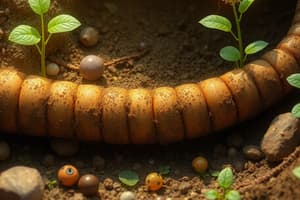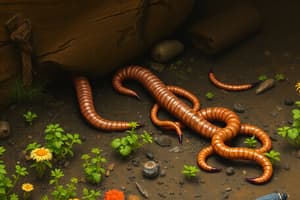Podcast
Questions and Answers
Which type of earthworm thrives in leaf litter and rotting logs, feeding on partially decayed matter?
Which type of earthworm thrives in leaf litter and rotting logs, feeding on partially decayed matter?
- Anecic earthworms
- Epigeic earthworms (correct)
- Endogeic earthworms
- Composting earthworms
What is the optimal pH range for earthworm survival?
What is the optimal pH range for earthworm survival?
- 9-11
- 7-9
- 5-8 (correct)
- 4-6
What ecological role do earthworms play in the soil?
What ecological role do earthworms play in the soil?
- They enhance soil fertility and aeration through burrowing. (correct)
- They decrease soil aeration and drainage.
- They reduce decomposition rates and nutrient cycling.
- They primarily feed on living plants, damaging crops.
Which of these factors is considered a significant predictor of endogeic earthworm density?
Which of these factors is considered a significant predictor of endogeic earthworm density?
What is the primary food source for composting earthworms?
What is the primary food source for composting earthworms?
Which earthworm category is known for creating permanent vertical burrows and dragging leaves into them?
Which earthworm category is known for creating permanent vertical burrows and dragging leaves into them?
What is the optimal temperature range for composting earthworms?
What is the optimal temperature range for composting earthworms?
What is the name of the system developed by Marcel Bouché for classifying earthworms?
What is the name of the system developed by Marcel Bouché for classifying earthworms?
Flashcards
Earthworm Diet
Earthworm Diet
Earthworms consume decaying organic matter and microorganisms.
Anecic Earthworms
Anecic Earthworms
Earthworms that live in permanent burrows and forage on the surface.
Composting Earthworms
Composting Earthworms
Earthworms that consume decaying plant matter, crucial for decomposition.
Epigeic Earthworms
Epigeic Earthworms
Signup and view all the flashcards
Moisture Requirement
Moisture Requirement
Signup and view all the flashcards
Temperature Range
Temperature Range
Signup and view all the flashcards
Optimal pH for Earthworms
Optimal pH for Earthworms
Signup and view all the flashcards
Soil Ecosystem Engineers
Soil Ecosystem Engineers
Signup and view all the flashcards
Study Notes
Food Habit and Habitat
- Earthworms eat various organic matter, including decaying roots, leaves, animal manure, and other organic material.
- They also consume living organisms like nematodes, protozoans, rotifers, bacteria, and fungi.
- Earthworms live in moist, compost-rich soil.
- Different earthworm types have diverse feeding niches and habitats.
- Anecic earthworms live in permanent burrows up to 3 meters deep, collecting food from the soil surface.
- Composting earthworms consume decaying plant matter and manure near the start of decomposition.
- Epigeic earthworms live in leaf litter and rotting logs, consuming partially decayed organic matter.
- Earthworms are often called "farmer's friends" due to their burrowing, which aerates soil and increases fertility.
Ecological Requirements
- Earthworms need specific conditions to survive, including moisture, temperature, pH, and organic matter.
- They thrive in moist soil (50-60%), rich in compost.
- Optimal temperature for composting earthworms is 55-80°F.
- Earthworms can tolerate a pH range of 5-8, but a neutral pH is ideal.
- They consume a wide variety of organic matter, including detritus, living protozoa, rotifers, nematodes, bacteria, fungi, and other microorganisms.
- Soil texture significantly impacts earthworm populations.
- Soil depth is not a significant predictor of earthworm richness and density.
- Precipitation is an indicator of endogeic earthworm density.
- Soil bulk density and porosity influence endogeic earthworm density and richness.
- Earthworms are considered ecosystem engineers because of their significant material ingestion and soil modification.
Ecological Categories of Earthworms
- French scientist Marcel Bouché defined ecological earthworm categories in the 1970s.
- These categories were based on physical characteristics (pigmentation, body length, color).
- Deep-burrowing earthworms (Anecic) create permanent vertical burrows in soil.
- They feed on surface leaves, dragging them into their burrows.
Studying That Suits You
Use AI to generate personalized quizzes and flashcards to suit your learning preferences.





